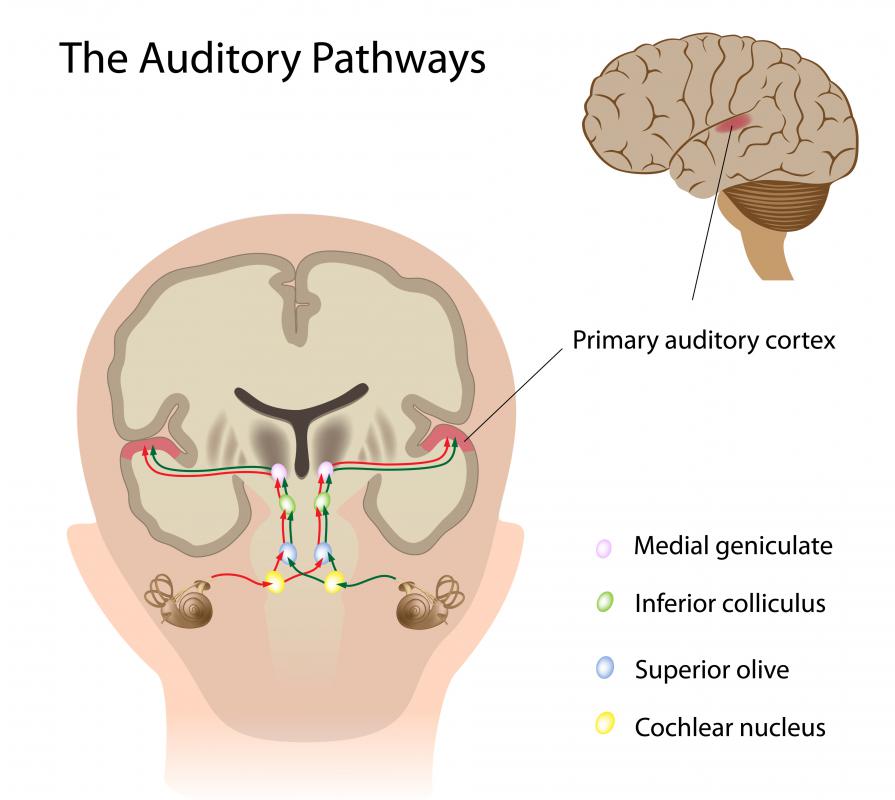At WiseGEEK, we're committed to delivering accurate, trustworthy information. Our expert-authored content is rigorously fact-checked and sourced from credible authorities. Discover how we uphold the highest standards in providing you with reliable knowledge.
What is Auditory Stimulation?
Auditory stimulation is the use of focused sounds to produce an effect on the nervous system. This sort of stimulation can be used as a part of sensory therapy in people with disabilities such as partial deafness or blindness or in people with attention deficit disorder or autism. It can also be used to help people develop or recover language skills, and might be applied as part of an accelerated learning program.
For people with hearing impairments or auditory processing disorders, auditory stimulation is believed to help increase their ability to process sounds. Some types of auditory stimulation allow a patient to manipulate sounds using gestures or body movement while other types might relate sound to visual stimulation like pictures or colors.

Auditory stimulation therapy can also be used for patients with disabilities in developing, understanding, or producing language, to train their brains to focus on the frequencies and sounds necessary to accurately interpret speech. This type of therapy combines listening to recorded music and language phonemes to increase the brain's ability to tune out “unnecessary” sounds, like background noise or very low frequency sounds.

People with autism, dementia, or brain damage can use combined sensory stimulation like Snoezelen Multi-Sensory Environment therapy for relaxation or learning purposes. Developed in the Netherlands, Snoezelen rooms are places where patients can manipulate lights, sounds, and various types of tactile stimuli to create an environment in which he or she is comfortable or happy. This type of therapy does not have a focused outcome, but rather is designed to stimulate and comfort the patient.

Auditory stimulation that combines music and language is central to the theory behind Suggestopedia, a language teaching method developed by Bulgarian psychologist Georgi Lozanov. This approach to second language learning combines Baroque music and a teacher reading target language material. Lozanov believes that music at 60 beats per minute, which mimics the human heartbeat, helps create a calm, relaxing environment where students lose their fears associated with learning, which leads them to acquire the new language more effectively.

Another type of auditory stimulation that builds on Lozanov’s theories is used in accelerated learning programs for gifted children. In this theoretical approach to learning, music is played at 60 beats per minute which is believed to create Alpha brain waves. In the Alpha state, the brain is thought to be most receptive to learning, so anything taught will be learned and retained more effectively.
AS FEATURED ON:
AS FEATURED ON:
















Discussion Comments
The application of therapeutic listening to educational uses for gifted children reminds me of the Mozart effect theory. The idea behind the Mozart effect is that if you listen to classical music long enough you will become brilliant.
I am exaggerating in a way I suppose, but that’s the basic premise. The idea is that there is something about the patterns and rhythms of classical music that mimics the activity of key learning centers in the brain, triggering increased learning at an accelerated pace.
I understand that some time ago the Mozart effect was more or less discredited but it still has many adherents. As for me, I like to listen to classical music throughout the day when I work. It certainly doesn’t do me any harm, except sometimes in the late afternoon when it almost puts me to sleep.
Who is qualified to assess auditory stimulation? An audiologist?
Post your comments